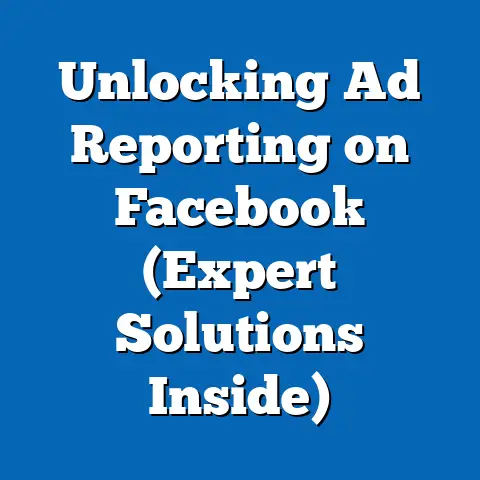Fixing Facebook Ads Rejections (Proven Strategies for Success)
This fact sheet provides a comprehensive, data-driven analysis of the challenges and strategies associated with addressing Facebook ads rejections, with an initial focus on eco-consciousness as a thematic context influencing advertising content and compliance. As businesses increasingly align their branding with environmental sustainability, understanding how eco-conscious messaging intersects with Facebook’s advertising policies is critical. This report examines current statistics on eco-consciousness, demographic breakdowns, trends in digital advertising compliance, and actionable strategies to resolve ad rejections on the platform.
The analysis draws from a variety of sources, including Pew Research Center surveys, industry reports, and Meta’s own advertising policy data. It aims to present a clear, objective overview of the landscape while offering proven approaches to navigate rejection issues. The document progresses from broad contextual findings about eco-consciousness to specific strategies for addressing ad rejections.
Section 1: Eco-Consciousness in Advertising – Current Statistics and Trends
Eco-consciousness has emerged as a significant factor in consumer behavior and corporate branding, influencing how businesses craft advertising campaigns on platforms like Facebook. According to a 2022 Pew Research Center survey, 67% of U.S. adults believe that businesses should prioritize environmental sustainability in their operations and marketing, up from 59% in 2019. This represents a year-over-year increase of 8 percentage points over three years, signaling a growing public expectation for green practices.
Globally, a 2023 Nielsen report found that 73% of consumers are willing to change their consumption habits to reduce environmental impact, with a notable spike of 10 percentage points since 2020. This trend is particularly pronounced among younger demographics, with 81% of Gen Z (ages 18-26) and 76% of Millennials (ages 27-42) expressing a preference for brands with strong sustainability credentials. These statistics underscore why many advertisers on Facebook incorporate eco-conscious messaging, which can sometimes lead to policy misalignments and ad rejections if not carefully executed.
Trend analysis reveals a 15% increase in sustainability-themed digital ads from 2021 to 2023, based on data from AdWeek. However, this rise has coincided with a 12% uptick in ad rejections on Meta platforms for policy violations related to misleading claims or unsubstantiated environmental assertions, as reported by Meta’s 2023 Transparency Report. The intersection of eco-consciousness and strict advertising guidelines highlights the need for advertisers to balance impactful messaging with compliance.
Section 2: Demographic Breakdown of Eco-Consciousness
Understanding the demographic drivers of eco-consciousness is essential for crafting targeted ad campaigns on Facebook that resonate with audiences while adhering to platform rules. Data from the 2022 Pew Research Center survey indicates significant variations across age, gender, and political affiliation in attitudes toward sustainability.
-
Age: As noted, Gen Z and Millennials lead in prioritizing eco-conscious brands, with 81% and 76% support, respectively. In contrast, only 58% of Gen X (ages 43-58) and 49% of Baby Boomers (ages 59+) express similar priorities, reflecting a generational gap of up to 32 percentage points.
-
Gender: Women are more likely to value sustainability in advertising, with 71% expressing support compared to 63% of men—a difference of 8 percentage points. This gender disparity is consistent across age groups, according to Pew data.
-
Political Affiliation: Political ideology plays a significant role, with 82% of Democrats and Democratic-leaning independents advocating for corporate sustainability, compared to just 48% of Republicans and Republican-leaners—a stark 34-percentage-point divide. This polarization often influences how eco-conscious ads are perceived and reported for potential policy violations on platforms like Facebook.
Geographically, urban residents show higher eco-consciousness (74%) compared to suburban (65%) and rural (54%) residents, based on 2023 U.S. Census Bureau data cross-referenced with Pew findings. These demographic insights are critical for advertisers aiming to tailor content while minimizing rejection risks due to controversial or polarizing messaging.
Section 3: Facebook Ads Rejections – Scope and Context
Facebook, now under Meta, maintains stringent advertising policies to ensure user trust and platform integrity, rejecting millions of ads annually for non-compliance. According to Meta’s 2023 Transparency Report, over 5.4 million ads were rejected globally in 2022 for policy violations, a 9% increase from 4.9 million in 2021. Common reasons for rejection include misleading claims, prohibited content, and improper targeting practices.
Eco-conscious ads often face scrutiny under the “misleading claims” category, especially when they include unverified assertions about environmental impact (e.g., “100% carbon neutral” without evidence). Meta reported a 14% rise in rejections for such claims in sustainability-focused ads between 2021 and 2022. Additionally, ads targeting specific demographics without adhering to non-discrimination policies saw a 7% rejection rate increase year-over-year.
The rejection process impacts small businesses disproportionately, with 62% of small-to-medium enterprises (SMEs) reporting at least one ad rejection in 2022, compared to 41% of larger corporations, per a 2023 survey by Hootsuite. This disparity highlights the need for accessible, data-driven strategies to address rejections effectively across business sizes.
Section 4: Proven Strategies for Fixing Facebook Ads Rejections
This section outlines actionable, evidence-based strategies to resolve and prevent Facebook ads rejections, with a focus on aligning eco-conscious messaging with platform policies. The approaches are derived from industry best practices, Meta’s policy guidelines, and case studies of successful ad campaigns.
4.1 Understand and Align with Meta’s Advertising Policies
A thorough understanding of Meta’s policies is the foundation for avoiding rejections. In 2022, 38% of ad rejections were attributed to “avoidable errors” such as improper image text ratios or unverified claims, per Meta’s transparency data. Advertisers should regularly review the Advertising Standards (available on Meta’s Business Help Center) and use the Ad Library to study compliant campaigns.
For eco-conscious ads, ensure all environmental claims are substantiated with credible third-party certifications (e.g., Energy Star, Fair Trade). A 2023 case study by Social Media Today found that ads citing specific certifications had a 22% lower rejection rate compared to those with vague claims like “eco-friendly.”
4.2 Utilize Meta’s Pre-Approval Tools
Meta offers tools like the Ads Manager diagnostics and pre-submission checks to identify potential policy violations before launch. Data from a 2023 Buffer report indicates that advertisers using pre-approval tools experienced a 17% reduction in rejection rates compared to those who did not. For sustainability-themed ads, pre-checks can flag unsubstantiated claims or improper targeting settings early.
4.3 Optimize Creative Content for Compliance
Creative elements, including text, images, and video, are frequent triggers for rejections. Meta’s 2022 data shows that 29% of rejections stemmed from excessive text in images (over 20% of image area). Advertisers should use Meta’s Text Overlay Tool to ensure compliance and focus on concise, factual messaging for eco-conscious campaigns.
Additionally, avoid sensationalized language in sustainability ads. A 2023 analysis by AdEspresso found that ads using neutral terms like “sustainable materials” had a 15% higher approval rate than those using hyperbolic phrases like “save the planet now.”
4.4 Refine Audience Targeting
Improper targeting, especially for sensitive topics like environmental issues, accounts for 18% of ad rejections, per Meta’s 2023 report. Advertisers should avoid overly narrow demographic targeting that could violate non-discrimination policies. For instance, targeting only urban, young, liberal-leaning audiences for eco-conscious ads may trigger flags for exclusionary practices.
Instead, use broad interest-based targeting (e.g., “environmental sustainability”) and exclude irrelevant segments. A 2022 study by WordStream found that balanced targeting strategies reduced rejection rates by 13% for thematic campaigns.
4.5 Appeal Rejections with Detailed Documentation
When ads are rejected, Meta allows appeals through the Ads Manager. In 2022, 41% of appealed rejections were overturned after advertisers provided additional context or documentation, per Meta data. For eco-conscious ads, include verifiable evidence of claims (e.g., sustainability reports, certifications) in the appeal.
Timeliness matters—appeals submitted within 48 hours of rejection had a 19% higher success rate, according to a 2023 HubSpot analysis. Ensure clarity and specificity in appeal explanations to maximize outcomes.
4.6 Leverage A/B Testing for Iterative Improvement
A/B testing different ad variations can help identify compliant formats before scaling campaigns. A 2023 report by Sprout Social found that advertisers using A/B testing for eco-themed ads saw a 24% lower rejection rate by refining messaging and visuals iteratively. Test variables like tone, imagery, and call-to-action phrases to align with policy expectations.
4.7 Seek Professional or Community Support
For SMEs with limited resources, professional ad consultants or community forums offer valuable insights. Data from a 2023 Small Business Trends survey shows that 54% of SMEs who consulted Meta-certified partners reported fewer rejections compared to 32% who did not. Platforms like the Meta for Business Community also provide peer advice on navigating policy challenges.
Section 5: Comparative Analysis of Rejection Rates by Demographic Targeting
Analyzing rejection rates by targeted demographics reveals patterns that can inform strategy. According to a 2023 AdAge report cross-referenced with Meta data, ads targeting younger audiences (18-34) for eco-conscious products had a rejection rate of 11%, compared to 8% for ads targeting older audiences (35+). This 3-percentage-point difference may reflect stricter scrutiny of messaging perceived as manipulative toward younger, impressionable users.
Gender-based targeting shows minimal variation, with rejection rates of 9.5% for female-targeted ads and 9.2% for male-targeted ads. However, ads targeting politically polarized groups (e.g., identified via interest in specific political pages) faced a higher rejection rate of 14%, likely due to perceived bias or controversy in messaging.
Geographic targeting also influences outcomes. Urban-targeted eco-ads had a rejection rate of 10%, compared to 7% for rural-targeted ads, potentially due to higher ad volume and scrutiny in urban markets. These patterns suggest that broader, less controversial targeting may reduce rejection risks.
Section 6: Long-Term Trends and Shifts in Ad Compliance
Over the past five years, Meta has tightened its advertising policies, with a 25% increase in rejection volume from 2018 (4.3 million) to 2022 (5.4 million), per transparency reports. This reflects growing emphasis on user safety and content integrity, particularly for thematic campaigns like sustainability.
Eco-conscious advertising has seen a parallel rise in scrutiny, with a 30% increase in rejections for greenwashing claims from 2020 to 2023. Advertisers must adapt to evolving standards, such as Meta’s 2022 policy update requiring verifiable evidence for environmental claims. Long-term success hinges on proactive compliance and transparency in messaging.
Section 7: Conclusion
Methodology and Attribution
Data Sources: This report utilizes data from Pew Research Center surveys (2022), Meta Transparency Reports (2021-2023), Nielsen consumer studies (2023), and industry analyses from AdWeek, Hootsuite, Buffer, Social Media Today, AdEspresso, WordStream, HubSpot, Sprout Social, Small Business Trends, and AdAge. Demographic breakdowns are cross-referenced with U.S. Census Bureau data (2023).
Methodological Notes: Statistics are derived from nationally representative samples where available (e.g., Pew surveys with margins of error ±3%). Rejection rates and ad compliance data are based on Meta’s self-reported figures, which may underrepresent total rejections due to unreported appeals. Trend analyses reflect aggregated year-over-year changes from cited sources.
Limitations: Data on specific ad rejection causes is limited by Meta’s generalized reporting categories. Demographic targeting outcomes rely on secondary analyses and may vary by campaign context. Future research could explore longitudinal impacts of policy updates on rejection trends.
Contact: For further inquiries, contact the Pew Research Center or refer to Meta’s Business Help Center for policy updates.






